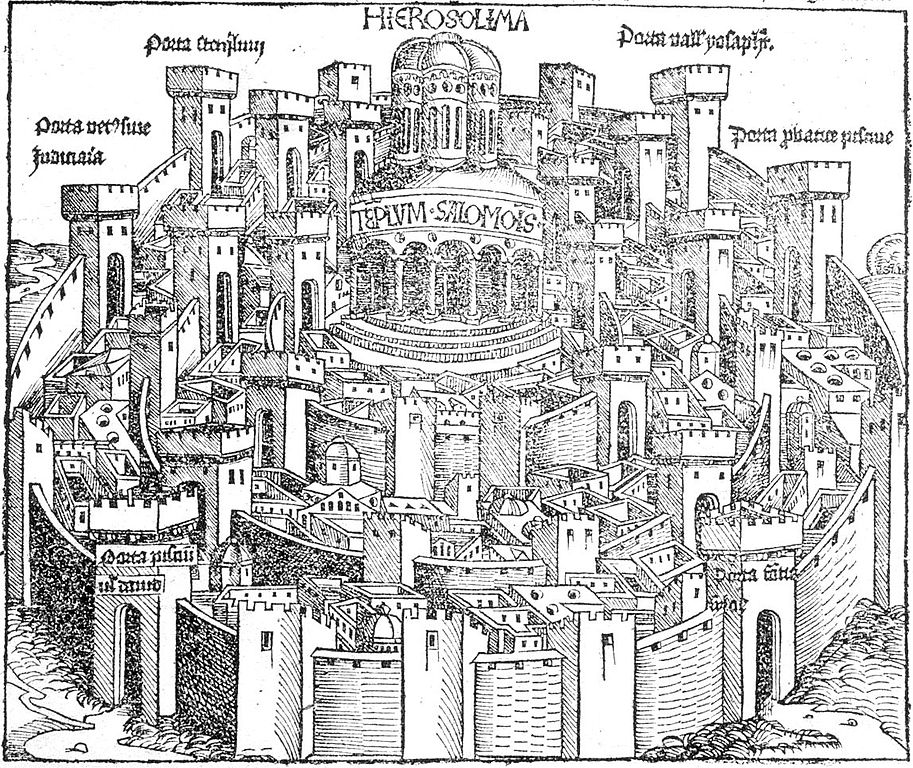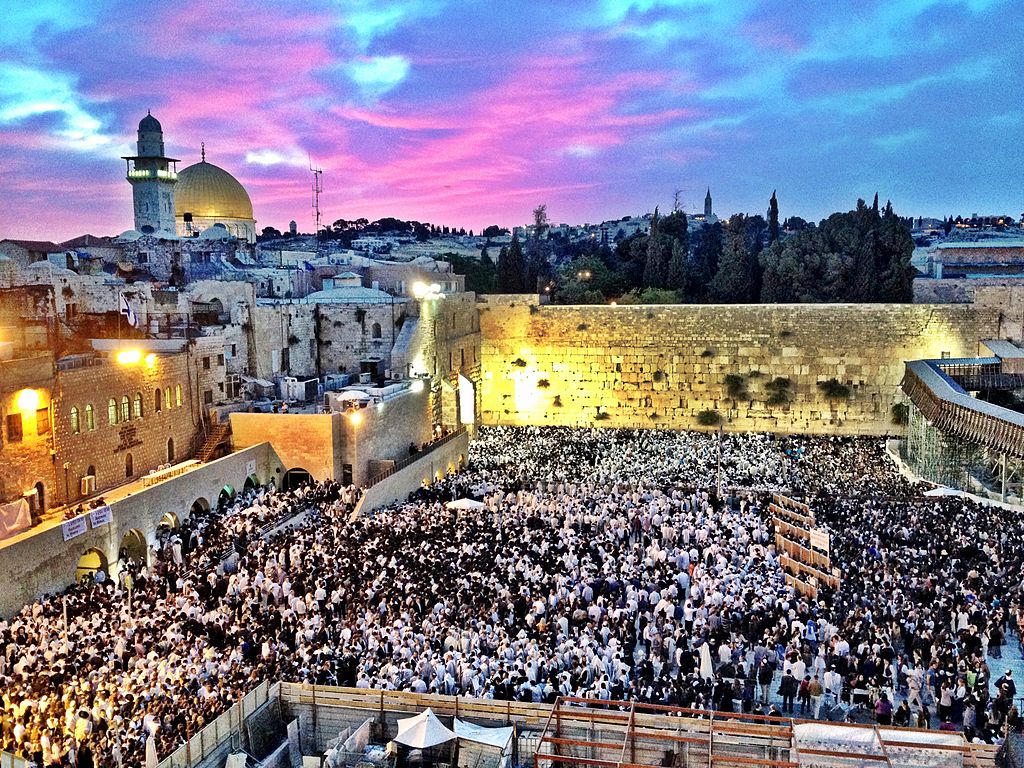Mount Moriah
Har HaMoriah (Mount Moriah) is the place of the Binding of Isaac, according to the Book of Chronicles (the last book of the Bible). At God’s request, Abraham took his son Isaac to bind him and offer him as a sacrifice. An angel stopped Abraham's hand, forbidding him to sacrifice his son. The name of this place is a play of words around the Hebrew verb ra'a (see): "So Abraham called that place YHWY yir'e (will see). And to this day it is said: ‘on Mount YHWH yira'e (to be seen)’.” (Genesis 22:14)
After King David conquered Jerusalem from the Jebusites, he moved the capital of his kingdom from Hebron to Jerusalem, a neutral city that did not belong to any of the twelve tribes of Israel, and was situated in the centre of his kingdom. The city is sometimes called ‘Ir David (City of David).
David ordered the Ark of the Covenant to be moved and carried to Jerusalem. God promised David that his son who would build the temple, and that his kingdom would be established forever (2 Samuel 7:12-16).
King Solomon, the son of David and Bathsheba, built the Temple on Mount Moriah, also called the Temple Mount or Har HaBeit (mount of the House) in Hebrew. The Temple itself was called Beit Hamiqdach (house of Sanctification).
Jewish worship was organised around the Temple in Jerusalem. The tribe of Levi was in charge of the worship, shared between the Levites and the Cohanim (plural of Cohen, priest), the direct descendants from Aaron, Moses’ brother. Daily sacrifices were held in the Temple. For the three annual pilgrimage festivals - Passover, Shavuot and Sukkot -, Jews were called to go up to Jerusalem.
According to the Talmud, the Temple hosted the Shekhinah (Presence of God, from the verb shaken, reside), a divine presence supposed to follow Jewish people in exile and, like them, hope for a return to Jerusalem. Jewish mysticism has compared the Shekhinah to a loving mother who cares for the fate of the Jewish people.
Fasting (from sunrise to sunset) started on the 17th of the month of Tammuz, a day commemorating the first breach in the First Temple by Babylonian troops in 586 BC and the first breach in the Second Temple by the Roman troops of Titus in 70 AD. This fasting opened a period of affliction lasting three weeks and ending on the day of 9 av by a longer fasting (from sunset to sunset the following day) reminding of the destruction of the First Temple and the Second Temple by these troops.
At the time of the Second Temple, King Herod the Great (73-4 BC) enlarged the esplanade of the Temple by surrounding the Temple Mount with a huge quadrilateral wall.
HaKotel HaMa’aravi (the Western Wall), often called HaKotel (the Wall) by Jews and Wailing Wall by Christians, is a vestige of this huge quadrilateral wall. This place became a sacred place because it was near the Holy of Holies of the Temple. The exact location of the Holy of Holies on the Temple Mount is unknown to these days.
Muslims built the Dome of the Rock and the al-Aqsa Mosque (the Distant) on the Temple Mount, called al-Haram ash-Sharif (the Noble Sanctuary).
Mount Zion
The name of Har Tzion (Mount Zion) is based on the Hebrew word tsyoun (landmark, signal). At first, it designated the Temple Mount for a long time. In the early centuries of the Christian era, this name was used to designate another hill situated nearby, a hill with the Tomb of King David and the church St. Peter in Gallicantu.
During the conquest of Jerusalem, the name Zion also referred to the original Jebusite city. “Nevertheless David captured the fortress of Zion - which is the city of David” (2 Samuel 5:7). Then Zion referred to the whole city during Biblical times, as well as the whole Judea and even all the people of Israel.
We find a parallelism between Zion and Jerusalem in Semitic rhetoric, in the following chiasmus: "Out of Zion will go forth the Torah and the word of YHWH from Jerusalem” (Isaiah 2:3).
With the destruction of the Second Temple in 70 AD and the exile of the Jewish people, Zion was a symbol of nostalgia for the Land of Israel, from early on, during the first Babylonian exile (from 597 to 538 BC), as evidenced by Psalm 137: “By the rivers of Babylon we sat and wept when we remembered Zion” (Psalm 137:1).
The hope for a return to Zion was expressed in Psalm 126, sung before the last blessings at the end of meals on Shabbat and on festival days: "When YHWH restored the fortunes of Zion, we were like those who dream. Then our mouth was filled with laughter, and our tongue with shouts of joy” (Psalm 126:1-2).
The first movement for a return to Israel began in the late nineteenth century, and took the name of Hovevei Zion (Lovers of Zion). It was followed by the creation of the Zionist movement in 1897 at the Basel Congress.
Tzniut (Zionism) is a political ideology to restore Jewish sovereignty as both nationalistic and emancipatory. It resulted in the creation of the State of Israel in 1948. It brought together various ideological options, from leftist to rightist, including the extreme right. Literally, anti-Zionism is the refusal to recognize the existence of the State of Israel as a sovereign and independent nation.
Jerusalem
A city called Salem was first mentioned when Malki-Tsedeq (Melchizedek) and Avraham (Abraham) met: "And Melchizedek, king of Salem, brought forth bread and wine: and he was the priest of the most high God” (Genesis 14:18).
Yerushalayim, the name of Jerusalem in Hebrew, holds the SH-L-M triliteral root stating peace (shalom), complete (shalam) and whole (shalem). The suffix -ayim is neither singular nor plural, but expresses the duality stated in the Talmud. The Talmud developed the idea of a heavenly Jerusalem that God would only join after entering the earthly Jerusalem.
The name of Jerusalem is cited many times in the Jewish liturgy, mainly to ask God to build again the city. The blessings after a meal, for example, include the following wish: "And may you build up Jerusalem, the holy city, speedily in our lifetimes. Blessed are You, YHWH, who in His mercy builds up Jerusalem. Amen.”
The nostalgia of Jerusalem is shown during the ritual meal of Passover (Easter) in the following phrase told by all the guests: “Next year in Jerusalem.”
The name of Jerusalem is also associated with joy during weddings. The nuptial blessings include the following verses: “Yet in the Judean mountains and the streets of Jerusalem (…), there will be heard once more the sounds of joy and gladness, the voices of bride and bridegroom” (Jeremiah 33:10-11). This blessing has become a famous song, both sung and danced in wedding celebrations
https://www.youtube.com/watch?v=maLqmM86a8E.
The centrality of Jerusalem, city of the Temple, is shown in some prayers: the faithful turn to the direction of the holy city to pray. The Holy Cabinet, holding the Torah scrolls in synagogues, is placed in the direction of Jerusalem. In some communities, families hang on a wall of their home a painting or a painted or engraved calligraphy showing the Mizrah (East) to indicate the direction of Jerusalem.
The relations between Jerusalem and the Torah are so strong that many cities of the Diaspora with main yeshivas (houses of study) are called Jerusalem. This is the case of Vilnius - the Jerusalem of Lithuania -, which was a major study centre of the Torah from the eighteenth century to the Holocaust.
The Partition Plan of Palestine into two States was voted by the United Nations on 29 November 1947. Jerusalem was supposed to become an international zone. But the wars between Israel and the neighbouring Arab States from May 1948 to January 1949 brought border changes. The western part of Jerusalem became part of Israel. The eastern part, including the Old City and the holy places, became part of Jordan. On 23 January 1953, Israel decided that West Jerusalem would be the capital of the State, a decision that was not recognized by the international community.
After the Jordanian conquest of the Old City, the Jewish quarter was entirely destroyed. Jews could no longer access the Western Wall until the Six-Day War (5-10 June 1967), when Israel conquered the eastern part of Jerusalem. On 30 July 1980, the State of Israel declared Jerusalem a “full and united capital”.
The status of Jerusalem has remained a difficult issue. It is a holy city for the three Abrahamic religions, but the only holy city for Jews, who are deeply attached to it, whereas Christians and Muslims also have Rome, Constantinople and Mecca as holy cities. It is therefore necessary to separate the religious issue from the political issue in order to find an acceptable compromise by both Israelis and Palestinians.
In contemporary Israel, Jerusalem is perceived as a city where religious coercion can be heavy, unlike the secular cities of Tel Aviv or Haifa. But there is a consensus to reject a closed border sharing the city between Israelis and Palestinians. To find a solution, belligerents need to take into account the special place of this city in history, and find a unique way to achieve peace, a peace that is stated by the name of Yerushalayim – Jerusalem – itself.








